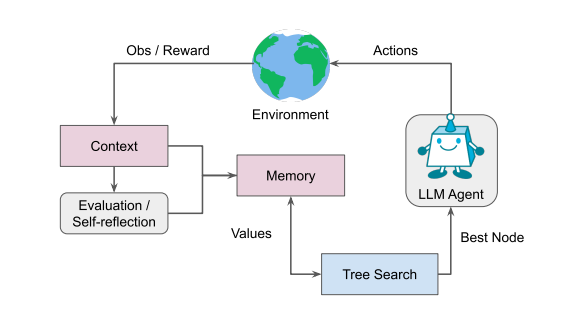Architectures for AI Agents

From simple to complex
AI agents are systems capable of reasoning, planning, and executing tasks autonomously. Unlike more static AI models, agents interact dynamically with their environment, adapting to new information and leveraging tools to accomplish complex objectives. Let's take a look at AI agent architectures and examine key considerations for their effective use. We'll start with basic agents and then move on to multi-agent systems (MAS).
Basic agents
Agents utilize a model, such as a Large Language Model (LLM), to manage and execute tasks. These systems leverage the extensive language comprehension and generation capabilities of current models. By integrating planning, reasoning, and tool execution within a single framework, agents are designed to handle a wide array of tasks autonomously. These agents typically operate in a structured manner, continuously refining their approach until they achieve the desired outcome.
Basic agents excel in environments where tasks are well-defined and require minimal feedback from external sources. Their streamlined architecture makes them easier to implement and manage. This simplicity translates to higher efficiency and consistency in executing straightforward function calls. For instance, tasks such as personal news aggregation, where the system compiles and summarizes news articles based on predefined criteria, are well-suited to basic agents. The agent can independently gather data, evaluate its relevance, and refine its output, ensuring a high level of precision and control.
At their most sophisticated, basic agents can integrate planning, acting, and reasoning using algorithms such as Monte Carlo Tree Search (MCTS). This method uses heuristic-based search to explore various options, and a state evaluator to choose the best action:

While such architectures can produce excellent results on simpler benchmarks, they are resource-intensive and may not perform as well on more complex tasks.
Despite their strengths, basic agents face significant challenges. One limitation is their propensity to get stuck in execution loops, especially when tasked with complex, multifaceted problems. Without the ability to receive feedback from other agents, a basic agent may repetitively generate the same actions, failing to progress towards the goal. Additionally, these systems may struggle with tasks requiring robust reasoning and refinement capabilities, as they lack the collaborative input that MAS provide. This limitation can lead to suboptimal outcomes, particularly in dynamic environments where adaptability and diverse perspectives are crucial.
For example, in scenarios like complex event planning, where multiple aspects such as venue selection, catering, and scheduling need to be managed simultaneously, a basic agent might falter. The absence of collaborative problem-solving can result in inefficiencies and errors, pointing to the need for MAS in such contexts.
Multi-Agent Systems (MAS)
MAS involve multiple agents, each potentially equipped with different language models and tools, working collaboratively to solve complex tasks. These systems simulate the dynamic interactions found in human teams, where each agent can contribute uniquely based on its specialized capabilities. For example, some agents might focus on data retrieval, while others handle analysis and report generation.
One of the primary strengths of MAS is their ability to handle complex tasks that require collaboration and parallel processing. This is particularly effective for problems that involve multiple distinct execution paths, where different agents can work concurrently to expedite the process. For instance, in a complex research task, one agent might gather relevant literature while another synthesizes the information, and yet another drafts a summary, all working simultaneously.
Additionally, MAS can leverage diverse expertise. By integrating agents with different specializations, the system can provide more comprehensive solutions than a basic agent. This diversity fosters robust problem-solving capabilities, enabling the system to adapt and respond to varied and unexpected challenges.
There are many MAS architectures, but they tend to employ two primary design principles: leader-follower and peer-to-peer. With leader-follower designs, a lead agent coordinates the activities of follower agents. This hierarchical approach ensures a clear division of labor, with each agent reporting back to the leader. While this can streamline decision-making and task allocation, it also risks creating information bottlenecks if the lead agent fails to effectively disseminate critical information.
With peer-to-peer designs, all agents operate on an equal footing, sharing information and decisions via message-passing. This egalitarian approach encourages collaboration and feedback. However, it can also lead to inefficiencies if agents engage in irrelevant communication, making it important to implement filtering and prioritization mechanisms.
Let's look at a few architectures making use of these principles.
MAS architectures
Structured teams
Agents can be structured to work in teams, with a particular focus on organized communication and leadership. The architecture typically includes modules for configuration, perception, memory, and execution, enabling agents to translate environmental observations into actions effectively.
The designated leader coordinates the actions of other agents, significantly improving task efficiency and reducing communication overhead. The leadership structure helps mitigate issues related to redundant messaging and disordered decision-making, common pitfalls in multi-agent cooperation. Structured teams can further improve their efficiency by continuously evaluating and optimizing their structure and communication patterns.
Dynamic teams
MAS can be structured in dynamic teams for handling complex reasoning and code generation tasks. The architecture assigns roles to agents based on their contributions and performance, ensuring that only the most effective agents are engaged in subsequent rounds of task execution. This peer-to-peer structure, devoid of a central leader, fosters an environment where agents can share information freely and adapt their strategies in real-time.
Dynamic teams allow for high flexibility and responsiveness, crucial for tasks that require continual adjustment and optimization.
Phased execution
An MAS architecture can segment task execution into distinct phases, such as recruitment, decision-making, agent execution, and evaluation. This phased approach is versatile, accommodating both leader-follower and peer-to-peer structures depending on the task requirements.
In the recruitment phase, agents are selected or removed based on their relevance to the task at hand. During decision-making, agents discuss and plan their approach, leveraging diverse perspectives to refine their strategy. This phase is followed by agent execution, where each agent independently performs its designated role. Finally, the evaluation phase involves assessing the outcomes and adjusting the team composition and strategies as needed.
This phased approach attempts to get the right agents engaged at the right times, enhancing the overall efficiency and effectiveness of the team.
Publish-subscribe communication
To avoid unproductive chatter in MAS, a design can enforce structured outputs and utilize a publish-subscribe mechanism for information sharing. Instead of engaging in free-form conversation, agents produce structured messages, which are then shared in a controlled manner. This approach significantly reduces unnecessary communication and ensures that all agents have access to relevant information.
The publish-subscribe mechanism further streamlines communication by allowing agents to subscribe only to the information pertinent to their tasks. This reduces cognitive load and improves focus, leading to more efficient task execution. Publish-subscribe communication can work particularly well in scenarios requiring extensive coordination and knowledge synthesis.
Approaches to reasoning
Effective AI agents must possess robust reasoning abilities to interact with complex environments, make informed decisions, and adapt to new information dynamically. Reasoning is fundamental to cognition, enabling agents to simulate human-like decision-making processes, thereby improving their problem-solving capabilities. There are several approaches to reasoning.
Task decomposition involves breaking down a complex task into smaller, manageable sub-tasks. By tackling each sub-task individually, agents can simplify problem solving, making it easier to achieve the overall objective. Task decomposition is particularly useful in scenarios where tasks are inherently hierarchical or sequential.
Multiple plan selection involves generating multiple potential plans for a given task and then selecting the optimal one based on predefined criteria. Multiple plan selection allows agents to explore various strategies and choose the best path forward, enhancing flexibility and adaptability.
Memory-augmented planning leverages memory to retain context and historical information. This enables agents to make informed decisions based on past experiences and adapt their strategies accordingly. By storing and retrieving relevant information, agents can improve their performance in tasks that require sustained attention and contextual understanding.
Agents frequently need to interact with external tools to solve complex problems, which often requires multiple iterations of reasoning, recall, and reflection. Tool-calling enhances the agent’s capabilities by providing access to specialized functions that extend beyond the built-in capabilities of a model.
The advantage of parallelism
MAS excel at managing parallel tasks, allowing different agents to work on separate subproblems simultaneously. This not only speeds up problem solving but ensures that tasks are handled by the agents best suited to their specific requirements. By dividing a larger problem into smaller, independent subproblems, MAS can also improve their robustness. Each agent focuses on a specific aspect of the task, and their collective efforts lead to a more comprehensive solution. This division of labor minimizes the risk of failure and enhances the system’s overall efficiency.
For example, in a scenario where a system is tasked with compiling a detailed market analysis report, one agent could be responsible for gathering raw data, another for analyzing trends, and a third for drafting the report. By working in parallel, these agents can produce a more thorough and timely analysis than a basic agent.
The range of MAS
While basic agents are well-suited for straightforward tasks with clearly defined tools, they often fall short in more complex and dynamic environments. MAS, on the other hand, have a broader range of capabilities, particularly excelling in collaborative and parallel task execution. The designs of MAS allow them to divide labor intelligently and adapt to feedback from both users and the environment. Effective feedback mechanisms make MAS more versatile and useful in complex problem-solving scenarios.
